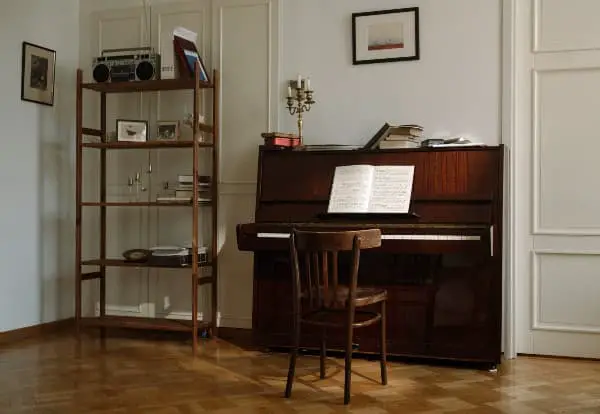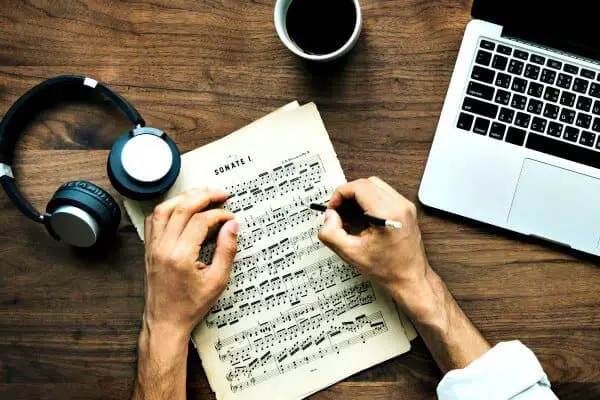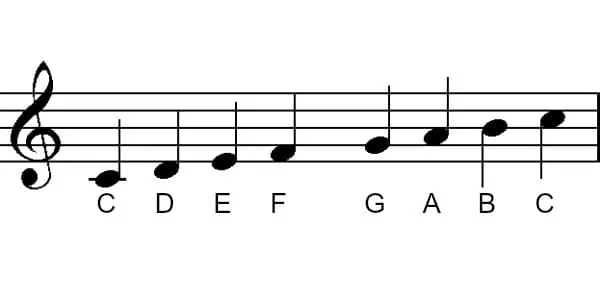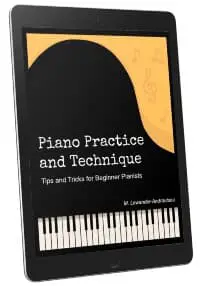- Home
- Learn to Read Music
- Read Piano Music
How to Read Piano Music
This article may contain compensated links. Please read the disclosure for more info.
Did you know that you can learn how to read piano music in shapes and patterns and not just by analyzing notes? Here you'll learn to become a better note reader by using musical and intuitive tools, not just music theory.
Read Piano Music: Theory vs Practice
When starting to read music, all beginner pianists have to learn the names of the notes. It’s also important to learn how to count note values and the rhythm.
These basic skills are fundamental for being able to read and play sheet music. And this theoretical part of learning to read piano music is also what most piano students are acquainted with.
But, it’s also important to understand that when actually playing and practicing; trying to decode each note name as you play, as well as trying to count the exact value of a note- will actually stop you from playing well.
This is where another kind of note reading comes in handy, and which we'll actually be using to read piano music more fluently in the longer run.
This practical part of note reading is like shorthand. It's a tool for making reading more intuitive. And it involves finding and identifying patterns; melodic and rhythmic patterns.

How to Learn a melody
A melody is, in essence, pitch and rhythm combined.
When learning a melody as a beginner, focus first on the pitches (the note heads):

After that, the rhythm (stems, flags or beams and rests etc.):

Finally, combine the melody and the rhythm:

As you become more skilled in reading piano music, you’ll be able to do this simultaneously. (Except perhaps sections of the music that are really difficult. Then, the method that you'll learn here will be useful as well.)
Pitches vs the Melodic Outline
In theory
First of all, you need to learn the note names. A B C D E F G (or Do/Ut Re Mi Fa Sol La Si, depending on where you are in the world). Yes, it’s basic but important. And fortunately rather easy:
- When first starting to play the piano, make a habit to always point and spell out each note before playing, and then as you play for each hand separately.
- Make sure to practice random notes on the staff by spending a little time each day identifying all the notes on each staff; both the treble/G-clef and bass/F-clef.
Tip: Print my free handy flashcards to practice with here: Treble clef notes, Bass clef notes.
In practice
However, as you practice the above, you will soon notice that it’s impractical and difficult to name each note as you play. Especially when you have learned to play it a little faster.
And you shouldn’t!
This is where the more “practical” approach to note reading comes in.
And it’s simple:
Notes in a melody move up and down. Sometimes next to each other in steps:

And sometimes with spaces in between, also called skips:

Notes are also repeated:

That’s it!
So, when learning a melody you should practice to recognize the melodic outline and how it moves. The shape of the melody.
Try this:
- Focus on a part of your melody, whatever hand is playing it.
- Then with your hand in front of you, follow and imitate how the melody moves up and down in steps, skips/leaps and repeats.

- Next, as you play slowly, focus on how it feels and sounds as you play the 3 patterns; steps, skips, and repeats. Listen attentively to the sound of the pitch going up and down.
Now you are reading the melody more fluently as you also will read piano music later on; as shapes and patterns.
- As you'll notice, there are only 3 melodic patterns. Always.
- And two patterns are really easy: steps and repeats.
- Skips or leaps are intervals. They need a little extra effort and can be learned as patterns as well. You can practice identifying and playing music intervals quickly here.
Rhythm
In theory
Basic note values
Learning to count the rhythm and the beat in music is essential as you learn to read piano music.
Start by learning basic note values: Whole, half, and quarter notes. These notes and their rests are worth whole beats.
Alterations

Next, learn about the alterations you can make with dots and ties.
- A dot behind the note prolongs a note with half its value. For example, a dotted half note is (usually): 2 beats + 1 beat (half of 2)= 3 beats long.
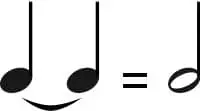
- A tie is a line between two notes of the same pitch. This makes the note longer with the combined note values. It’s like gluing two music notes together. (Th notes must be the same pitch, though.)
Note Values Shorter Than A Beat
Continue to learn the note values and rests shorter than a beat, eight notes, sixteenth notes, and so on. They are often combined in different patterns and are lots of fun to play!
Counting

The time signature (the two numbers at the beginning of the staff) tells you how many beats you have in each measure (top number). And it also tells you the type of note worth one beat (the bottom number symbolizes a note value).
Ex. The most common time signature is 4/4. It tells us the beats in the piece are grouped in 4 (top 4). And the quarter note (bottom 4) is worth 1 beat.
In this example, you'll see how a basic rhythm is counted based on the time signature (the number of beats per measure):

This way of counting note values is important to practice as you read piano music. But there comes a time when counting with numbers like this becomes very impractical and may actually stop you from playing fluently.
In this example, you'll see how counting the beats (top) becomes rather unmusical. However, the rhythm syllables (below it) will make you learn the rhythm much faster and more musically so:

Please note that there is more than one way of counting and using rhythm syllables. This is a method I use with my students since it works very well.
In Practice
Rhythm Syllables
So, as we saw above, when you start playing more complex melodic rhythm patterns, with notes shorter than a beat mixed up, like rests and so on, counting with numbers becomes rather clumsy.
But if you learn to use rhythm syllables, as you practice to read piano music, you will have all the tools you need!
Rhythm syllables are a way of sounding the rhythm before you play. It’s simple and easy to use and will make tricky rhythm patterns super easy and fun to play.
For example:
You can learn this rhythm below by counting the numbers of the beats in the measure (1 and 2 and 3 and and and 4 and etc.) or by chanting syllables:

You might notice that using syllables makes it almost too easy!
However;
- For simple rhythms and longer note values, it’s still useful to count with numbers, though.
- Likewise, you'll need to count using numbers while playing both hands with different rhythms played simultaneously.
But for isolating tricky rhythms in a melody, rhythm syllables win every time!
Summary
When you read piano music to learn a melody, you need to learn the pitches, the melodic movement, counting, and rhythm patterns.
Learning The Notes/Pitches
- Theory: Learn the names of the notes.
- Practice: As you play focus on the outline of the melody, and how the notes move in 3 distinct patterns; steps, repeated notes and skips/leaps.
Learning The Rhythm
- Theory: Learn how to count the beats in each measure.
- Practice: Learn to use rhythm syllables, especially for places where the rhythm gets more complex and uses note values shorter than a beat.
